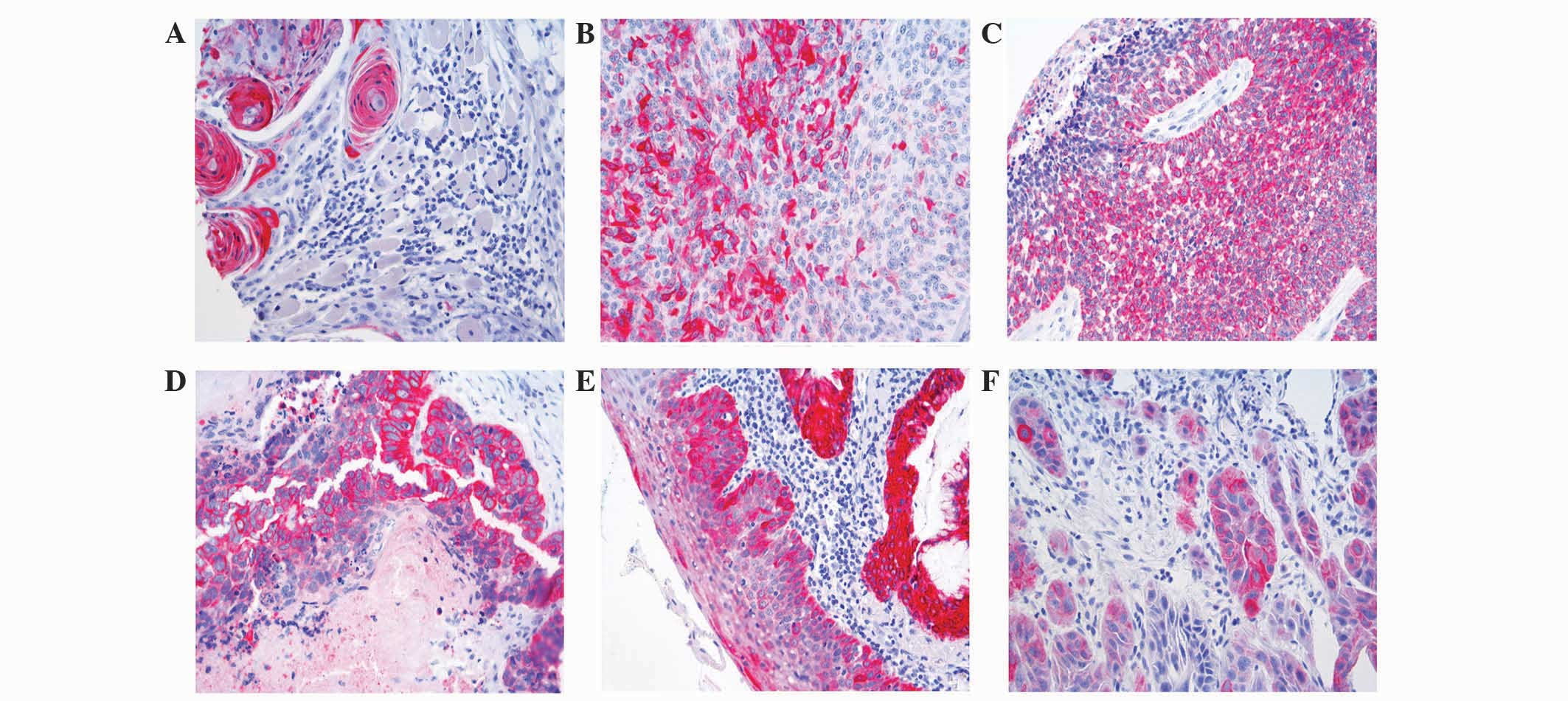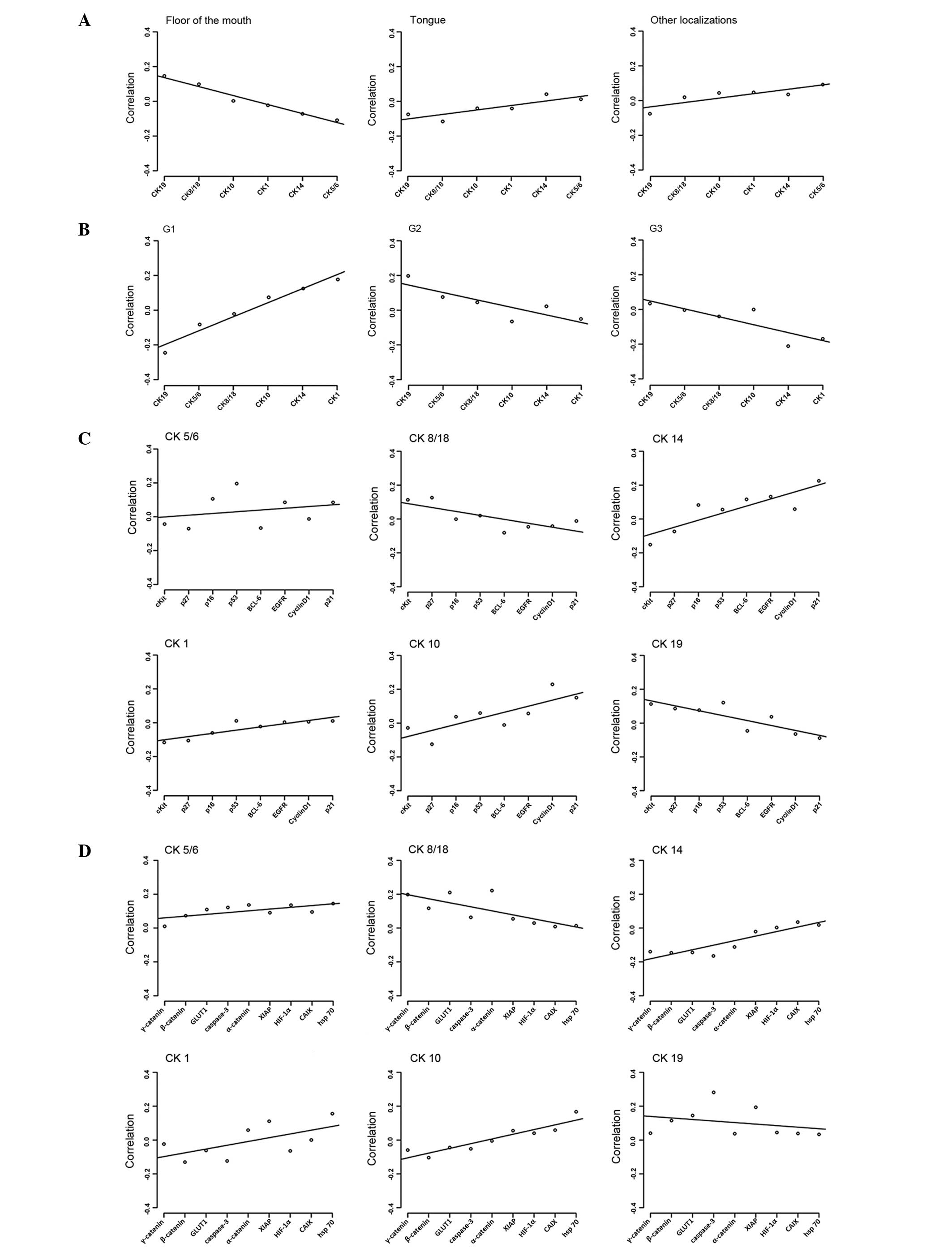|
1
|
Scully C and Bagan J: Oral squamous cell
carcinoma overview. Oral Oncol. 45:301–308. 2009. View Article : Google Scholar : PubMed/NCBI
|
|
2
|
American Cancer Society: Cancer Facts
& Figures 2015. American Cancer Society. Altanta, GA: 2015.
|
|
3
|
Cancer Research UK: Oral cancer incidence
statistics. http://www.cancerresearchuk.org/health-professional/cancer-statistics/statistics-by-cancer-type/oral-cancer/incidence.s
|
|
4
|
D'Cruz AK, Vaish R, Kapre N, Dandekar M,
Gupta S, Hawaldar R, Agarwal JP, Pantvaidya G, Chaukar D, Deshmukh
A, et al: Head and Neck Disease Management Group: Elective versus
therapeutic neck dissection in node-negative oral cancer. N Engl J
Med. 373:521–529. 2015. View Article : Google Scholar : PubMed/NCBI
|
|
5
|
Yamauchi K, Fujioka Y, Kogashiwa Y and
Kohno N: Quantitative expression study of four cytokeratins and p63
in squamous cell carcinoma of the tongue: Suitability for sentinel
node navigation surgery using one-step nucleic acid amplification.
J Clin Pathol. 64:875–879. 2011. View Article : Google Scholar : PubMed/NCBI
|
|
6
|
Slaughter DP, Southwick HW and Smejkal W:
Field cancerization in oral stratified squamous epithelium;
clinical implications of multicentric origin. Cancer. 6:963–968.
1953. View Article : Google Scholar : PubMed/NCBI
|
|
7
|
Chu PG and Weiss LM: Keratin expression in
human tissues and neoplasms. Histopathology. 40:403–439. 2002.
View Article : Google Scholar : PubMed/NCBI
|
|
8
|
Moll R, Franke WW, Schiller DL, Geiger B
and Krepler R: The catalog of human cytokeratins: Patterns of
expression in normal epithelia, tumors and cultured cells. Cell.
31:11–24. 1982. View Article : Google Scholar : PubMed/NCBI
|
|
9
|
Fillies T, Werkmeister R, Packeisen J,
Brandt B, Morin P, Weingart D, Joos U and Buerger H: Cytokeratin
8/18 expression indicates a poor prognosis in squamous cell
carcinomas of the oral cavity. BMC Cancer. 6:102006. View Article : Google Scholar : PubMed/NCBI
|
|
10
|
Fillies T, Jogschies M, Kleinheinz J,
Brandt B, Joos U and Buerger H: Cytokeratin alteration in oral
leukoplakia and oral squamous cell carcinoma. Oncol Rep.
18:639–643. 2007.PubMed/NCBI
|
|
11
|
Alam H, Gangadaran P, Bhate AV, Chaukar
DA, Sawant SS, Tiwari R, Bobade J, Kannan S, D'Cruz AK, Kane S and
Vaidya MM: Loss of keratin 8 phosphorylation leads to increased
tumor progression and correlates with clinico-pathological
parameters of OSCC patients. PLoS One. 6:e277672011. View Article : Google Scholar : PubMed/NCBI
|
|
12
|
Gires O, Mack B, Rauch J and Matthias C:
CK8 correlates with malignancy in leukoplakia and carcinomas of the
head and neck. Biochem Biophys Res Commun. 343:252–259. 2006.
View Article : Google Scholar : PubMed/NCBI
|
|
13
|
Raul U, Sawant S, Dange P, Kalraiya R,
Ingle A and Vaidya M: Implications of cytokeratin 8/18 filament
formation in stratified epithelial cells: Induction of transformed
phenotype. Int J Cancer. 111:662–668. 2004. View Article : Google Scholar : PubMed/NCBI
|
|
14
|
Alam H, Kundu ST, Dalal SN and Vaidya MM:
Loss of keratins 8 and 18 leads to alterations in
α6β4-integrin-mediated signalling and decreased neoplastic
progression in an oral-tumour-derived cell line. J Cell Sci.
124:2096–2106. 2011. View Article : Google Scholar : PubMed/NCBI
|
|
15
|
Lindberg K and Rheinwald JG: Suprabasal 40
kd keratin (K19) expression as an immunohistologic marker of
premalignancy in oral epithelium. Am J Pathol. 134:89–98.
1989.PubMed/NCBI
|
|
16
|
Paramio JM and Jorcano JL: Beyond
structure: Do intermediate filaments modulate cell signalling?
Bioessays. 24:836–844. 2002. View Article : Google Scholar : PubMed/NCBI
|
|
17
|
World Medical Association: World Medical
Association Declaration of Helsinki. Ethical principles for medical
research involving human subjects. Bull World Health Organ.
79:373–374. 2001.PubMed/NCBI
|
|
18
|
Barton A: Handbook for good clinical
research practice (GCP): Guidance forsimplementation. J Epidemiol
Community Health. 61:5592007. View Article : Google Scholar
|
|
19
|
Fillies T, Woltering M, Brandt B, Van
Diest JP, Werkmeister R, Joos U and Buerger H: Cell cycle
regulating proteins p21 and p27 in prognosis of oral squamous cell
carcinomas. Oncol Rep. 17:355–359. 2007.PubMed/NCBI
|
|
20
|
Fillies T, Werkmeister R, van Diest PJ,
Brandt B, Joos U and Buerger H: HIF1-alpha overexpression indicates
a good prognosis in early stage squamous cell carcinomas of the
oral floor. BMC Cancer. 5:842005. View Article : Google Scholar : PubMed/NCBI
|
|
21
|
Fillies T, Buerger H, Gaertner C, August
C, Brandt B, Joos U and Werkmeister R: Catenin expression in T1/2
carcinomas of the floor of the mouth. Int J Oral Maxillofac Surg.
34:907–911. 2005. View Article : Google Scholar : PubMed/NCBI
|
|
22
|
Sobin LH, Gospodarowicz MK and Wittekind
C: UICC TNM Classification of Malignant Tumours (7th).
Wiley-Blackwell. Hoboken, NJ: 2009.
|
|
23
|
Packeisen J, Buerger H, Krech R and
Boecker W: Tissue microarrays: A new approach for quality control
in immunohistochemistry. J Clin Pathol. 55:613–615. 2002.
View Article : Google Scholar : PubMed/NCBI
|
|
24
|
Schymik B, Buerger H, Krämer A, Voss U,
van der Groep P, Meinerz W, van Diest PJ and Korsching E: Is there
‘progression through grade’ in ductal invasive breast cancer?
Breast Cancer Res Treat. 135:693–703. 2012. View Article : Google Scholar : PubMed/NCBI
|
|
25
|
Helms MW, Packeisen J, August C, Schittek
B, Boecker W, Brandt BH and Buerger H: First evidence supporting a
potential role for the BMP/SMAD pathway in the progression of
oestrogen receptor-positive breast cancer. J Pathol. 206:366–376.
2005. View Article : Google Scholar : PubMed/NCBI
|
|
26
|
Packeisen J, Korsching E, Herbst H,
Boecker W and Buerger H: Demystified…tissue microarray technology.
Mol Pathol. 56:198–204. 2003. View Article : Google Scholar : PubMed/NCBI
|
|
27
|
Botstein D and Fink GR: Yeast: An
experimental organism for 21st Century biology. Genetics.
189:695–704. 2011. View Article : Google Scholar : PubMed/NCBI
|
|
28
|
Vidal M, Cusick ME and Barabási AL:
Interactome networks and human disease. Cell. 144:986–998. 2011.
View Article : Google Scholar : PubMed/NCBI
|
|
29
|
Buerger H, Boecker F, Packeisen J,
Agelopoulos K, Poos K, Nadler W and Korsching E: Analyzing the
basic principles of tissue microarray data measuring the
cooperative phenomena of marker proteins in invasive breast cancer.
Open Access Bioinformatics. 5:1–21. 2013.
|
|
30
|
Warnakulasuriya S: Global epidemiology of
oral and oropharyngeal cancer. Oral Oncol. 45:309–316. 2009.
View Article : Google Scholar : PubMed/NCBI
|
|
31
|
Petti S: Lifestyle risk factors for oral
cancer. Oral Oncol. 45:340–350. 2009. View Article : Google Scholar : PubMed/NCBI
|
|
32
|
Moergel M, Kammerer P, Kasaj A, Armouti E,
Alshihri A, Weyer V and Al-Nawas B: Chronic periodontitis and its
possible association with oral squamous cell carcinoma - a
retrospective case control study. Head Face Med. 9:392013.
View Article : Google Scholar : PubMed/NCBI
|
|
33
|
Feller L, Wood NH, Khammissa RA and Lemmer
J: Human papillomavirus-mediated carcinogenesis and HPV-associated
oral and oropharyngeal squamous cell carcinoma. Part 1: Human
papillomavirus-mediated carcinogenesis. Head Face Med. 6:142010.
View Article : Google Scholar : PubMed/NCBI
|
|
34
|
Feller L, Wood NH, Khammissa RA and Lemmer
J: Human papillomavirus-mediated carcinogenesis and HPV-associated
oral and oropharyngeal squamous cell carcinoma. Part 2: Human
papillomavirus associated oral and oropharyngeal squamous cell
carcinoma. Head Face Med. 6:152010. View Article : Google Scholar : PubMed/NCBI
|
|
35
|
AWMF and GAOOAM: Surgery Guidelines for
Oncology, S3: Guideline for diagnostics and treatment of oral
cancer. AWMF-Register-Number (007–100O, 2012L). 119:2012.(In
German).
|
|
36
|
Frerich B: Standard therapy of oral
squamous epithelial carcinoma. Onkologe. 16:527–536. 2010.(In
German). View Article : Google Scholar
|
|
37
|
Institut RK and GEKID: Cancer in Germany
2007/2008. Journal. 137:2012.(In German).
|
|
38
|
Steinert PM, Idler WW and Zimmerman SB:
Self-assembly of bovine epidermal keratin filaments in vitro. J Mol
Biol. 108:547–567. 1976. View Article : Google Scholar : PubMed/NCBI
|
|
39
|
Romano V, Bosco P, Rocchi M, Costa G,
Leube RE, Franke WW and Romeo G: Chromosomal assignments of human
type I and type II cytokeratin genes to different chromosomes.
Cytogenet Cell Genet. 48:148–151. 1988. View Article : Google Scholar : PubMed/NCBI
|
|
40
|
Thiel UJ, Feltens R, Adryan B, Gieringer
R, Brochhausen C, Schuon R, Fillies T, Grus F, Mann WJ and Brieger
J: Analysis of differentially expressed proteins in oral squamous
cell carcinoma by MALDI-TOF MS. J Oral Pathol Med. 40:369–379.
2011. View Article : Google Scholar : PubMed/NCBI
|
|
41
|
Zhong LP, Chen WT, Zhang CP and Zhang ZY:
Increased CK19 expression correlated with pathologic
differentiation grade and prognosis in oral squamous cell carcinoma
patients. Oral Surg Oral Med Oral Pathol Oral Radiol Endod.
104:377–384. 2007. View Article : Google Scholar : PubMed/NCBI
|
|
42
|
Korsching E, Packeisen J, Agelopoulos K,
Eisenacher M, Voss R, Isola J, van Diest PJ, Brandt B, Boecker W
and Buerger H: Cytogenetic alterations and cytokeratin expression
patterns in breast cancer: Integrating a new model of breast
differentiation into cytogenetic pathways of breast carcinogenesis.
Lab Invest. 82:1525–1533. 2002. View Article : Google Scholar : PubMed/NCBI
|
|
43
|
Korsching E, Jeffrey SS, Meinerz W, Decker
T, Boecker W and Buerger H: Basal carcinoma of the breast
revisited: An old entity with new interpretations. J Clin Pathol.
61:553–560. 2008. View Article : Google Scholar : PubMed/NCBI
|
|
44
|
Schiffman M, Castle PE, Jeronimo J,
Rodriguez AC and Wacholder S: Human papillomavirus and cervical
cancer. Lancet. 370:890–907. 2007. View Article : Google Scholar : PubMed/NCBI
|
|
45
|
Kurman RJ and Shih Ie M: Molecular
pathogenesis and extraovarian origin of epithelial ovarian
cancer-shifting the paradigm. Hum Pathol. 42:918–931. 2011.
View Article : Google Scholar : PubMed/NCBI
|
|
46
|
Rajagopalan H, Nowak MA, Vogelstein B and
Lengauer C: The significance of unstable chromosomes in colorectal
cancer. Nat Rev Cancer. 3:695–701. 2003. View Article : Google Scholar : PubMed/NCBI
|
|
47
|
Lee BH, Roh S, Kim YI, Lee A and Kim SY:
Difference of genome-wide copy number alterations between
high-grade squamous intraepithelial lesions and squamous cell
carcinomas of the uterine cervix. Korean J Pathol. 46:123–130.
2012. View Article : Google Scholar : PubMed/NCBI
|
|
48
|
Tornesello ML, Buonaguro L, Giorgi-Rossi P
and Buonaguro FM: Viral and cellular biomarkers in the diagnosis of
cervical intraepithelial neoplasia and cancer. Biomed Res Int.
2013:5196192013. View Article : Google Scholar : PubMed/NCBI
|
|
49
|
Helms JA, Cordero D and Tapadia MD: New
insights into craniofacial morphogenesis. Development. 132:851–861.
2005. View Article : Google Scholar : PubMed/NCBI
|
|
50
|
Diewert VM: Development of human
craniofacial morphology during the late embryonic and early fetal
periods. Am J Orthod. 88:64–76. 1985. View Article : Google Scholar : PubMed/NCBI
|
|
51
|
Moore KL and Persuad TVN: The Developing
Human: Clinicall Oriented Embryology (8th). Saunders/Elsevier.
Philadelphia, PA: 2007.
|
|
52
|
Löfdahl HE, Du J, Näsman A, Andersson E,
Rubio CA, Lu Y, Ramqvist T, Dalianis T, Lagergren J and Dahlstrand
H: Prevalence of human papillomavirus (HPV) in oesophageal squamous
cell carcinoma in relation to anatomical site of the tumour. PLoS
One. 7:e465382012. View Article : Google Scholar : PubMed/NCBI
|
|
53
|
Li R, Koch WM, Fakhry C and Gourin CG:
Distinct epidemiologic characteristics of oral tongue cancer
patients. Otolaryngol Head Neck Surg. 148:792–796. 2013. View Article : Google Scholar : PubMed/NCBI
|
















